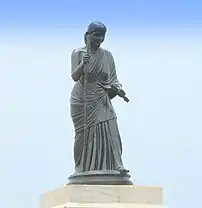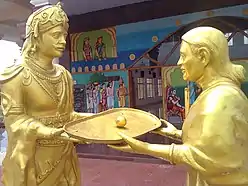
Avvaiyar (Tamil: ஔவையார்) was a Tamil poet who lived during the Sangam period and is said to have had cordial relations with the Tamil chieftains Vēl Pāri and Athiyamān. She wrote 59 poems in the Puṟanāṉūṟu.[1] A plaque on a statue of the poet in Chennai suggests the first century BCE for her birthdate.[2][3] The name Avvaiyar means a 'respectable good woman', hence a generic title; her personal name is not known.[4]
Biography
Avvaiyar is considered to be contemporary to poets Paranar,[5] Kabilar and Thiruvalluvar.[6] She is attributed as the author of 7 verses in Naṟṟiṇai, 15 in Kuṟuntokai, 4 in Akanaṉūṟu and 33 in Puṟanāṉūṟu.[5] Legend states that she was a court poet of the rulers of the Tamil country. She travelled from one part of the country to another and from one village to another, sharing the gruel of the poor farmers and composing songs for their enjoyment. Most of her songs were about a small-time chieftain Vallal Athiyamaan Nedumaan Anji and his family.[5] The chieftain had also used her as his ambassador to avert war with another neighbouring chieftain Thondaiman.[5] The rest of her songs related to the various aspects of state governance. Although traditions claim that she was a sister of Kabilar, Thiruvalluvar and Athiyamaan, V. R. Ramachandra Dikshitar refutes this claim based on his studies that all four of them were most likely of different walks of life, thus from different caste backgrounds and hence impossible to be siblings. Tirukkovilur is an ancient temple town in Tamil Nadu. This is where the demon Andhaka was killed by Lord Shiva. Sangam epics recount that it was here that Avvayar was blessed with a vision of her lord slaying Andhaka and she has dedicated verses to the same. At great ancient temple of Thillai Chidambaram she sang Vinayakar Thiruakaval when Lord Ganesha displayed his dancing form to her. Vinayakar Thiruakaval is an extremely esoteric work.[6]
View on Valluvar and the Kural
It is said that Avvaiyar was one of the several scholars who were present at the time when Valluvar submitted his masterpiece of the Tirukkural at the Madurai College. Soon after the presentation and the subsequent acceptance by the scholars and the Pandiyan King, Idaikkadar praised Valluvar and the Kural text thus:[7]
The Cural contains much in a little compass. Such is the ingenuity of its author, that he has compressed within its narrow limits all the branches of knowledge, as if he had hollowed a mustard seed, and enclosed all the waters of the seven seas in it. [Emphasis in original]
On hearing this, Avvaiyar remarked to him that it would be more appropriate to liken the Kural text to an atom, which is even smaller than a mustard seed.[7] Both Idaikaadar and Avvaiyar's remarks appear as the last two verses of the Tiruvalluva Maalai.
Legend
A popular legend in Tamil is the story of the Avvaiyar and the Naaval (Jambu) tree. Avvaiyar, believing she had achieved everything that is to be achieved, was pondering her retirement from Tamil literary work while resting under a Naaval tree. She was then met by a disguised Murugan (regarded as one of the guardian deities of the Tamil language; the god of war, victory, and knowledge), who jousted with her wittily. He later revealed himself and made her realise that there was still a lot more to be done and learned.

Another legend has it that once the great king Athiyaman gave an "eternal" gooseberry (Nellikani in Tamil) fruit to Avvaiyar. It was a special fruit that would bestow on whoever ate it a very long and healthy life. Athiyaman wanted Avvaiyar to eat the eternal fruit as she was the right person who could serve the Tamil community. If she could live forever, so would the Tamil heritage and language.[8]
While on a visit to Ceylon, Avvai was caught up in torrential rain, and took shelter in the house of two women of lower caste, Angavay and Sangavay. These women took care of Avvai with great kindness and the poet promised that they would be given in marriage to the King of Tirucovalur. On hearing this the King agreed to take the women in marriage if they were given away by the Chera, Chola and the Pandya kings. Avvai then made an invocation to Ganesha for making the invitation on a palmyra leaf, on which Ganesha appeared before her. On receiving the invitation the kings from the three kingdoms come to the wedding ceremony and gave Angavay and Sangavay away in marriage. (pp. 57–59).[9]
Shrine
In Muppandal, a small village in the Kanyakumari District of Tamil Nadu. there is an image of Avvaiyar. By tradition, this is stated to be the spot where the great poet left the mortal world.[10]
Legacy
In her poetical illustration ![]() Hindoo Temples and Palace at Madura. of 1835, Letitia Elizabeth Landon writes of Avvaiyar's (Avyia's) triumph and calls her "One who upon the scroll Flung the creative soul, Disdainful of life's flowers and of its rest."[11]
Hindoo Temples and Palace at Madura. of 1835, Letitia Elizabeth Landon writes of Avvaiyar's (Avyia's) triumph and calls her "One who upon the scroll Flung the creative soul, Disdainful of life's flowers and of its rest."[11]
In 1991, a 20.6 km-wide crater in Venus was named the Avviyar crater by the International Astronomical Union.[12]
Her quote "கற்றது கைமண் அளவு, கல்லாதது உலகளவு" has been translated as "What you have learned is a mere handful; What you haven't learned is the size of the world" and included in NASA's Cosmic Questions Exhibit.[13]
Further reading
- Subramanyam, K. (1974). A Look at Some Tamil Classics. Indian Literature, 17(1/2), pp. 204–216.
- Sivakumar, R. (2000). Sangam Poetry. Indian Literature, 44(2 (196)), pp. 182–192.
- Thompson, M. S. H. (1948). The Avvai of the Sangam Anthologies. Bulletin of the School of Oriental and African Studies, the University of London, 12(2), pp. 399–402.
See also
Notes
- ↑ "News Archives". The Hindu. Archived from the original on 26 January 2013.
- ↑ Subramanian, V. K. (1996). Sacred Songs of India. Abhinav Publications. p. 105. ISBN 978-81-7017-420-2.
- ↑ Sah, Purnima (11 September 2019). "Tracing the significance of statues along the Marina stretch". The Times of India. Retrieved 30 April 2023.
- ↑ Mukherjee, Sujit (1999). A dictionary of Indian literature. India: Orient Blackswan. p. 32. ISBN 978-81-250-1453-9.
- 1 2 3 4 Amaresh (2006). The Encyclopaedia of Hindu literature. Sahitya Akademi. p. 295. ISBN 978-81-260-1803-1.
- 1 2 Dikshitar, Ramachandra (2007). Studies in Tamil Literature and History. Read Books. pp. 65–70. ISBN 978-1-4067-7245-6.
- 1 2 Robinson, 2001, p. 27.
- ↑ "Guidelines for helping the needy". The Hindu. Archived from the original on 25 January 2013.
- ↑ Edward Jewitt Robinson (1873). Tamil Wisdom; Traditions Concerning Hindu Sages, and Selections from their writings. London: Wesleyan Conference Office.
- ↑ Padmanabhan, S. (5 November 2004). "Shrine for the Tamil poetess". The Hindu. Chennai, India. Archived from the original on 1 January 2005. Retrieved 28 October 2006.
- ↑ Landon, Letitia Elizabeth (1835). "poetical illustration". Fisher's Drawing Room Scrap Book, 1836. Fisher, Son & Co.Landon, Letitia Elizabeth (1835). "picture". Fisher's Drawing Room Scrap Book, 1836. Fisher, Son & Co.
- ↑ "Planetary Names: Crater, craters: Avviyar on Venus". Gazetteer of Planetary Nomenclature. International Astronomical Union (IAU) Working Group for Planetary System Nomenclature (WGPSN). 2006. Retrieved 8 February 2019.
- ↑ "Cosmic Questions Exhibit". NASA. Archived from the original on 2 November 2012.
References
- Edward Jewitt Robinson (2001). Tamil Wisdom: Traditions Concerning Hindu Sages and Selections from Their Writings. New Delhi: Asian Educational Services. ISBN 9788120615878.
- Krishnamurti, Dr. C.R. (Professor Emeritus, University of British Columbia, Vancouver, B.C. Canada) Thamizh Literature Through the Ages
- Project Madurai – Purananuru eText – http://tamilnation.org/literature/ettuthokai/pm0057.pdf
- Project madurai – Avvaiyar works in PDF – http://tamilnation.org/literature/auvaiyar/pm002.pdf
- http://www.aathithamizharperavai.com/home.html
- https://web.archive.org/web/20110308182216/http://www.tn.gov.in/policynotes/archives/policy2004_05/hrce2004-05-3.htm
External links
- Project Madurai Homepage
- Avvaiyar & her Writings
- Aathisoodi Meaning in English - Translated into English